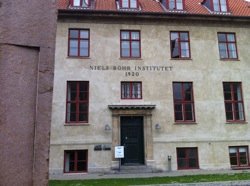
Like my friend and colleague Peter Coles, I am just returned from the fine wine-soaked dinner for the workshop “Cosmology and Astroparticle physics from the LHC to PLANCK” held at the Niels Bohr Institute in Copenhagen. It is an honor to visit the place where so many discoveries of 20th Century physics were made, and an even greater honor to be able to speak in the same auditorium as many of the best physicists of the last hundred years.
(You can see the conference photo here; apparently, the trumpet is just the latest in a long series.)
I talked about the most recent results from the Planck Satellite, gave an overview of the state of the art of (pre-Planck) measurements of the Cosmic Microwave Background, and found myself in what feels like the unlikely role as a mouthpiece for a large (and therefore conservative) community, basically putting forward the standard model of cosmology: a hot big bang with dark matter, dark energy, and inflation — a model that requires not one, not two, but (at least) three separate additions to particles and fields that we know from terrestrial observations: one to make up the bulk of the mass of today’s Universe, another to make the Universe accelerate in its expansion today, and another to make it accelerate at early times. It would sound absurd if it weren’t so well supported by observations.